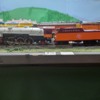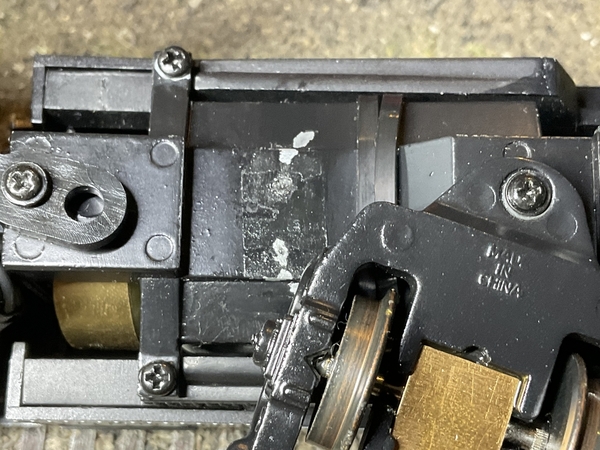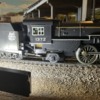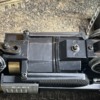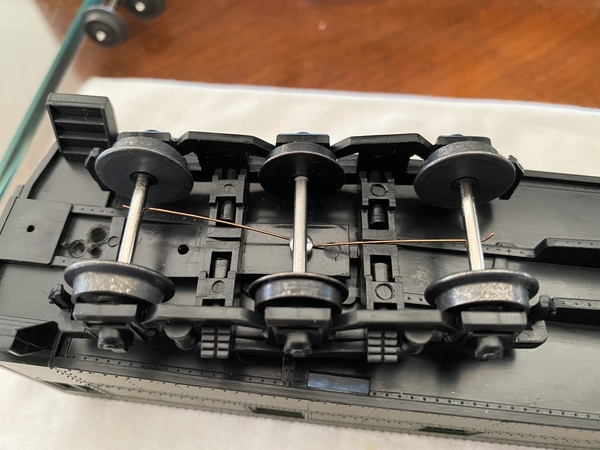I have recently acquired an American Models Chippewa 4-6-2 locomotive. this locomotive has metal wheels on the trailing truck. This is a beautifully done engine but I run on original AC Gilbert track. I noticed when I inspected the engine what looked like scratches on the back of the engine where the wheels contacted the chassis. When I ran the engine on my layout I saw where the trailing truck wheels were arcing when they contacted the chassis on the Gilbert curves. Has anyone else run into this and if so, how did you alleviate the problem? My thought is either smaller diameter wheels, plastic wheels, or to remove some material from the chassis, I am open to suggestions.
Replies sorted oldest to newest
Try removing (grinding ) a small amount of metal from above the wheels on the frame, dont mess with the wheels. then just touch it up with black paint , about 1-1.5 mm should do it. I have had the same thing happen with S scale brass engines. PS do you have the cars?
I have two observations from your picture. I'm a long-time O gauge railroader but have never owned any S.
The engine looks low at the tail end and the tender looks low at the front end. Neither looks to be sitting level. I think the front of the tender is low because the engine is pushing downward on the front of the drawbar. Before you do any grinding of the shell you might consider the following. If there is a spring between the chassis and the trailing truck, replace it with a stiffer spring or stretch the existing spring. This should raise the tail end of the engine and give the trailing wheels more clearance. Also examine the drawbar mounting at the tender.
MELGAR
@MELGAR posted:I have two observations from your picture. I'm a long-time O gauge railroader but have never owned any S.
The engine looks low at the tail end and the tender looks low at the front end. Neither looks to be sitting level. I think the front of the tender is low because the engine is pushing downward on the front of the drawbar. Before you do any grinding of the shell you might consider the following. If there is a spring between the chassis and the trailing truck, replace it with a stiffer spring or stretch the existing spring. This should raise the tail end of the engine and give the trailing wheels more clearance. Also examine the drawbar mounting at the tender.
MELGAR
I have the same engine in front of me and the dont dip, the engines in AF or High rail, were designed to run on their High rail/ scale track. as you can see in the photo the track is a bit off and that with the tighter, AF curves are causing the arcing , I have run S scale engines on flyer track and had some do the same thing. The one I have here #12 AC Flyer with w Chug and smoke has the same wear marks (but no arcing) under the fire box/ motor mount. You may want to call AM and talk to their tech guy. I ve seen this engine run on a layout made of AM track and AC power with no shorting. to amend my previous post , maybe try to insulate the underside of the fire box/motor mount, piece of contact piper to insulate it from the rear truck
Have the wheels spun on a lathe to trim them down to the diameter you need,….you can chase the tire, and the flange to keep them looking like they’re stock…
Pat
I agree with Melgar.
@Ron H posted:I agree with Melgar.
Yeah. I hadn't noticed it initially, but it certainly looks like it's not sitting level...
Mark in Oregon
Guys, ….look real close at the picture, …..it looks like Ray just plopped it on the tracks for a photo op,….the pilot truck is all slung in between the rails, and it doesn’t look like the rear tender truck is sitting on the rails correctly,….it looks like he was just taking a picture of the engine so we’d all know what model he’s talking about, ……name with a face sorta thing,..
Pat
That's a good point Pat; but the pilot truck being "down" like that should only serve to lower the front end, yet it looks like it's slopping down back towards the cab end...🤔 🙂
Mark in Oregon
There is a bit of optical distortion in the photo also; look at the roof lines of the cars on the back track.
Ray..........I have a southern crescent limited that I have run for many years without any problems. As you already know I also run on Gilbert track.
Since you bought it 2nd hand, I would examine it very closely to see if has been altered. Its probably a minor problem but will be difficult to solve.
Jackie
Ray.....If you decide to change the the back drivers I have a 2 set of wheels one with rubber tires and on without......
Jackie
Hi Guys,
Sorry but not been to the computer for a couple of days, thanks to all for input.
Dave: The removal of some material from the chassis is what I may address on the engine. I do not have the Chippewa cars but I do have a number of Polar Express cars that have been repainted in the Pioneer Express scheme. I am considering a repaint on this engine to Pioneer Express scheme, I'll attempt to add a link to Stream Style Graphics and a picture of PE locomotive.
streamstyle graphics - Bing images
Melgar and Pat, Good eyes, I did go back and check the track at that location, there is a sag in the roadbed that I will address but that is not the problem on the curves. the engine and tender sit level on level track.
harmonyards, The locomotive is on the track all wheels on the rails, a poor picture taken in to much hurry. I plan to remove some material from the bottom of the chassis.
Jackie, When I purchased the engine the man who sold it mentioned the contact points under the firebox, did not realize it was actually arcing from wheels shorting against the chassis. I put the engine upside down in my cradle and put a curved piece of Gilbert track on the wheels and that actually put the trailing truck wheels under the lowest part of the chassis. I think the original owner had similar problems with the engine and that is why it was not run much. I don't see a reason to change the rear set of drivers but I will be replacing the traction tire which are on the front set of diving wheels on the Chippewa.
Ray
Ray, your post caused me to examine my three AM Pacifics. I have a New Haven, a Southern Pacific and a Southern Crescent. All three are the same at the firebox and trailing truck area, the differences are in the cowcatcher and engine accessories.
These pictures were not easy to arrange so the clearance shows, I used the NH since it was handy. I have run this engine for a long time on Gilbert track laid on carpet, then on solid rail flex permanently installed on a layout. On the permanent layout the wheels never touch the chassis but it is very close. If I did not have generous vertical easements for the grades the wheels would make contact at the start of the grade. They do not make contact on any radius curve on perfectly flat track. The clearance appears to be about 1/32”.
The areas where the wheels have rubbed on the chassis are visible, there is also some minor pitting on the wheel flanges. This was from running on the floor layouts with uneven track.
In my opinion the easiest and best fix is to put a strip of electrical tape across the bottom of the chassis where the rub marks are visible.
Attachments
Corrective action completed. I took the picture prior to reinstalling the trailing truck. The engine runs fine, the tape is thin enough to not contact the flanges on level track.
This New Haven runs great, Goldinhands converted it to TMCC/Railsounds plus an electrocoupler. It pulls a nine car set of American Models NH heavyweights, six are their 70’ cars and three are their 80’ cars.
Attachments
Please let us know how well the tape holds up. The glue on electrical tape does not always hold well and often comes loose after a time.
I thought that may happen. I elected to just apply the tape as is. If it does not adhere long term I would put on an additional glue to hold it in place.
I think it would also work to attach thin pieces of plastic to the underside of the chassis with epoxy. Might be a more permanent fix.
Another idea would be to remove the rear truck pivot screw and insert a washer between the chassis and the top of the truck. Just a thought.
MELGAR
Placing a washer between the rear truck mount and chassis does not help. The washers just cause the nose of the trailing truck to point downward, they do not raise the chassis. Raising the rear of the chassis will just cause the rear drivers to loose contact with the rails, not a good thing. Looking closely at the above picture the mating joint between the chassis and the motor is visible. The tape is applied to the motor enclosure, the brass flywheel on the back of the motor is visible in the cab.
There are two other possibilities. One is to order scale replacement wheels for the trailing truck. The other way is to buy a set of the AM thin traction bands for the rear drivers. The Pacifics do not have traction tires, AM sells thin bands that can be glued in place on the rear drivers. Adding these traction bands changes the chassis angle on the track, raising the motor almost 1/32" at the trailing truck wheels. I have some of these and test fit them, I think they will also solve the problem. I am fine with the black tape I added.
Here is a picture of an AM heavyweight three axle truck. The center wheels are scale, the outer wheels are high rail. The reduced height of the scale flange should work.
Attachments
I had trouble backing through Flyer switches & removed some metal from bottom of shell.( or the top of trailing truck ) I think the AM rubber drive wheels should be on the rear .
Bob G.
AmFlyer, try Kapton tape instead. Clean the surface with 91% isopropyl alcohol first to remove any oils, grease, or now electrical tape adhesive residue (which eventually it leaves behind). Allow to dry and then apply the Kapton. It is thinner, pretty tough to cuts/abrasion, and holds fast longer than electrical tape. You could put two layers of it on to be safe before you come close to the thickness of electrical tape. I use it now in many applications instead of masking or electrical tape although those are more appropriate in some applications. There's a variety pack of Kapton in different widths. I think I bought mine off Amazon. Dave
Thanks Dave. Kapton is likely the better choice. All I had on hand were some rolls of electrical tape so I used it. At least now we will know how long it will adhere to the bottom of the motor housing.
Ray.......why don't you try putting the traction wheels on the back axle. This might give you a little height for clearance of the trailing truck..... I know it will work since this is what I did when I put traction tires on my Crescent Limited. Just an idea................
Jackie
I am always learning on OGR forum. Thanks for introducing me to polyimide Kapton tape.
Charlie
Jackie,
I thought I had asked about the traction you put on your Southern Crescent locomotive, but maybe it didn't send. Did you put the tires that are cemented on or did you use the Gripton wheels from American Models? My engine has the Gripton wheels on the front axle, should they be on the rear axle?. This is my first AM steamer so I don't know the location where they should be, input appreciated.
Dave, thanks for the suggestion on the Kapton tape, got a roll here but didn't think about using it.
Dave Koeler, I would appreciate the list of Jim's equipment that you are handling, also, any ideas of where to go for the trailing truck you mentioned?
Thanks all,
Ray
Ray, I will contact you with the information
Ray.......I bought the Gripton wheel assembly from American Models. I placed them in the first slot at the cab. I didn't give a second thought about putting them on the front. They work just fine.
What I was thinking the rubber tire might raise the chassis just little for better clearance. Of course, that means gripton tires on the front might cause the rear of the chassis to be lowered.
Ray do you run a ES44AC Loco?.....I bought one this summer and it runs fine on fasttrack but stop/starts on Gilbert Track........
Regards
Jackie
PS
My AM Pacific was a pre Gripton era..........AM is discontinuing Gripton on diesel engines. I talk with someone at AM and he said people complained the rubber tires would break and gum up the engine.??????????
Jackie,
I don't think Gilbert tinplate track is the greatest track for conductivity if using newer more "fussy" type engines containing electronics. Neither is a dirty track. If you use an abrasive device to clean your track, you may want to research some of the postings concerning ways of cleaning track. According to some, abrasives impart microscopic scratches in the material of the rails. The normal dirt and crud from running your trains finds it's way into those scratches and reduces conductivity. There is a listing of liquid type cleaning agents with varying degrees of conductivity enhancement that can be used in cleaning track. I personally have switched to the use of mineral spirits for cleaning my AM track. I use 3 948 track cleaning cars in a row, the 1st set of pads contains the mineral spirits and the rest are dry. 4 or 5 passes around and I remove the 1st set of pads and replace with dry pads for a few passes. It seems that the intervals between track requiring cleaning is much longer. Before cleaning I wipe a small section of rail with a paper towel to check the track condition and after the cleaning process there is always a huge difference. I run all types of the newer stuff and never have a problem and seen no effect on traction tires. Just a suggestion.
Rich
Ray do you run a ES44AC Loco?.....I bought one this summer and it runs fine on fasttrack but stop/starts on Gilbert Track........
Jackie,
I do not have an ES44AC locomotive but I do have friends that have run theirs on my layout, these are also run on a portable layout that goes to shows, they run fine on the Gilbert track.
Question for you, did you buy new or used? If new, did you clean the wheels, I have U-boats and and SD-70, they all run fine on the Gilbert track. On some of the Flyonel locomotives there was some kind of protectant on the wheels that I had to remove, needed a solvent like mineral spirits to get it off the wheels.
As richabr stated above I also now use the mineral spirits to clean my track and wheels when needed, and I do find the track stays clean longer.
I have had some of the Flyonel equipment that I purchased new which had poor solder joints that I needed to clean and re-solder, some of the electrical connections had no solder but were held together with something like silicone.
I have updated all of my pre-Gripton diesels with the Gripton wheels, on my grades without traction the wheels slipped to much, my grades are only 1 to 1-1/2 percent but I pull trains of 20 cars and more.
I hope you can find the problem with your engine, do let us know how you make out with it.
When you replaced the wheels on your Pacific did you have any problems getting everything in the proper order? I have heard that replacing the wheels on an AM steam engine can be difficult, any suggestions?
Ray
Perhaps I am making a bad assumption but I thought the replacement Gripton steam engine drivers were a pair of wheels mounted on an axle with a drive gear. The cover would be removed and the wheelsets swapped after disconnecting the drive rods. At least that is how AM sells the diesel replacement Gripton drivers.
@AmFlyer posted:Perhaps I am making a bad assumption but I thought the replacement Gripton steam engine drivers were a pair of wheels mounted on an axle with a drive gear. The cover would be removed and the wheelsets swapped after disconnecting the drive rods. At least that is how AM sells the diesel replacement Gripton drivers.
Yeah Tom,
I am not sure but I thought on the forum there were questions about not getting all the wheels in correctly. I haven't had an AM steamer apart but I want to know what to look for if there is a certain procedure to follow.
Ray
I see, that would be good to know. I have not taken an AM Pacific apart. It is fairly easy to replace wheelsets in AM diesels.
The AM Northerns easily pull 20 car freights up 2.5% grades. I use the NH Pacific to pull a 9 car green NH heavyweight passenger consist. The pacific is at its limit, a 10th coach would likely stall it (wheel spin) on the 2.5% grade, and those coaches are very free wheeling. If they were Gilbert passenger cars five might be the limit.
@Rayin"S" posted:Hi Guys,
Sorry but not been to the computer for a couple of days, thanks to all for input.
Dave: The removal of some material from the chassis is what I may address on the engine. I do not have the Chippewa cars but I do have a number of Polar Express cars that have been repainted in the Pioneer Express scheme. I am considering a repaint on this engine to Pioneer Express scheme, I'll attempt to add a link to Stream Style Graphics and a picture of PE locomotive.
streamstyle graphics - Bing images
Melgar and Pat, Good eyes, I did go back and check the track at that location, there is a sag in the roadbed that I will address but that is not the problem on the curves. the engine and tender sit level on level track.
harmonyards, The locomotive is on the track all wheels on the rails, a poor picture taken in to much hurry. I plan to remove some material from the bottom of the chassis.
Jackie, When I purchased the engine the man who sold it mentioned the contact points under the firebox, did not realize it was actually arcing from wheels shorting against the chassis. I put the engine upside down in my cradle and put a curved piece of Gilbert track on the wheels and that actually put the trailing truck wheels under the lowest part of the chassis. I think the original owner had similar problems with the engine and that is why it was not run much. I don't see a reason to change the rear set of drivers but I will be replacing the traction tire which are on the front set of diving wheels on the Chippewa.
Ray
I sent you and e mail about 2 weeks ago; did you get it? if not I can resend! Spent several hrs looking for Wheels for the trailing truck, with no luck. The wheels on the A.M. engine are 20 mm, at the flanges. They need to be about 18mm to clear the frame. My suggestion of doing an inside frame trailing truck, (like Milwaukee Road had on their Pacific's) could be done, with a lathe and the axel set from a A.F. Alco pa dummy . or GP ( they are 22mm and would need to be turned down to 18mm Solid wheel . or a spoked wheel P. 319, #196 or 197, In Precision scale 0 scale steam locomotive catalog. ( I do recommend calling A.M. , tell them of the arching issues, and see if they have a fix)
Dave,
I didn't find an email from you, please send it again.
Ray
I'll be on the lookout for some wheels, thanks
@Rayin"S" posted:Dave,
I didn't find an email from you, please send it again.
Ray
I'll be on the lookout for some wheels, thanks
sent
@Rayin"S" posted:Yeah Tom,
I am not sure but I thought on the forum there were questions about not getting all the wheels in correctly. I haven't had an AM steamer apart but I want to know what to look for if there is a certain procedure to follow.
Ray
I wonder if Rusty Traque might have an answer, he is quite knowledgeable on AM equipment.
Ray
Good thought. He has not logged into the forum since 7/31.
Ray......Thanks for the information on cleaning the wheels......no I didn't clean my wheels on the new engine. I have a blue N&W es44ac and it ran fine from the beginning.
Am wheel sets are fairly easy to install, I had no problems when I put them on. I just checked and I have 3 sets of AM pacific drive wheels, 1 set of gripton wheels, set of no flange wheels and the set I removed and replaced with Gripton wheels. All have a center gear and bearings. I think I just rocked the set and it fell in place.
Jackie
@Rayin"S" posted:I wonder if Rusty Traque might have an answer, he is quite knowledgeable on AM equipment.
Ray
Ray, I believe Rusty was band from this forum... something about copyright infringement -- I think. It was a total surprise to me, but I do think a lifetime banishment, without a warning, is a bit of overkill. He really was a great contributor for the S side of this forum and is missed, at least by me.
Tom Stoltz
in Maine
@Tom Stoltz posted:Ray, I believe Rusty was band from this forum... something about copyright infringement -- I think. It was a total surprise to me, but I do think a lifetime banishment, without a warning, is a bit of overkill. He really was a great contributor for the S side of this forum and is missed, at least by me.
Tom Stoltz
in Maine
Really? Him too? Gee... first bob2 and then Rusty.
I might get "banned" for saying this, but those are great losses to this forum.
Mark in Oregon





